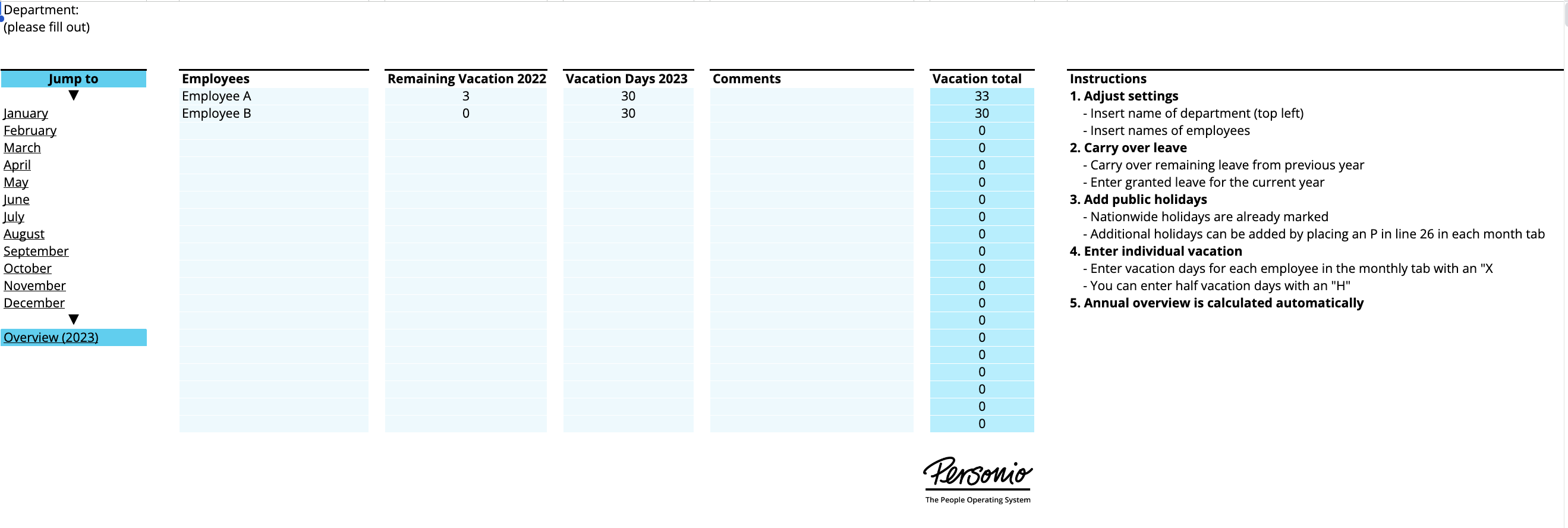Staff Holiday Planner & Tracker: Tips & Free Template

Are you looking for a staff holiday planner? One of the top challenges many organisations face is finding ways to efficiently track holidays. It’s not only a matter of good record-keeping but allows for better transparency across teams (we’ll explain how later on).
In this article, we make the case for staff holiday planners and even offer our own template (and solution) for tracking holidays for your team. We hope you find the read helpful.
Skip right to the chase and download our staff holiday planner template today.What is a staff holiday planner?
A staff holiday planner or holiday tracker is how organisations document and track holidays. This includes who is out of the office, for how long and even the type of leave they are taking.
For organisations of any shape or size, keeping a close eye on who’s in, who’s out and for how long is absolutely essential. If you don’t currently have a staff holiday planner of some kind in place, you’re risking:
A general lack of transparency across your organisation.
Misalignment between teams (especially dangerous in customer-facing roles).
Overall lack of productivity as employees aren’t sure when people are in.
Why does your organisation need a holiday tracker?
Let’s start by talking about holidays. The average domestic holiday in the UK lasts 3.3 days, with holidays abroad lasting around 8.7 days, according to research from NimbleFins. Given an average holiday entitlement of 28 days, the average result is 8.5 separate domestic or 3.2 international trips.
Even in an organisation of 25 people, that’s potentially 212.5 domestic or 80 international total trips that need to be requested and recorded. And, the more people you onboard, the more that number scales higher and higher.
Right there is the case for a great staff holiday planner. If employees are requesting, on average, somewhere between 4-6 trips each of varying lengths, it’s necessary that your HR team track them (and track them well).
Many organisations still track and manage holidays with a manual process that includes steps like:
Checking whether the employee is eligible for the amount of holiday they are requesting. With a manual system, employees can’t check their available PTO balance themselves, so the manager or HR team has to do it.
Aligning with the employee’s manager on their current projects to see if anything will be negatively impacted by their absence. (This doesn’t necessarily mean their request should be denied, but it’s good to know in advance how operations will be impacted.)
Looking at the holiday tracker to check for overlapping PTO requests (i.e. if other employees have requested holiday at the same time). Organisations will often try to minimise overlap so the team doesn’t struggle with too many concurrent absences.
If the holiday is approved, adding the dates to the holiday tracker and doing any necessary planning for the employee’s absence.
Having a holiday tracker is crucial to stay organised with the PTO of all employees.
The downsides of manually tracking holidays
When handled manually, the process of tracking holidays has a multitude of downsides:
Time-intensive | As you can see from the steps listed above, manually tracking holidays takes up a lot of time for the responsible admin. It also means the employee likely has to wait longer to find out if their holiday has been approved. |
Too much effort | The manual process adds unnecessary complications and requires more effort from the admin. |
Error-prone | Trying to remember the holiday requests someone asked for in the hallway or on Slack can lead to mistakes. So can manually entering dates into a tracker or checking PTO allowances against old contract documents. |
Distracting | All of the tasks required to track holidays manually are simply a distraction from other valuable work. The time spent and errors made can disrupt operations and decrease the productivity of the HR team. |
Compliance challenges | There are likely regulations around holiday time in your jurisdiction that need to be complied with. Manual tracking could leave the organisation vulnerable to legal action and fines. |
How do you organise staff holidays?
There are generally three agreed-upon ways to track and centralise various types of leave. These include:
Crafting a tracking template and using a holiday request form.
Purchasing a specialised leave planning system.
Investing in an all-in-one HR software with an absence management feature.
To be sure, each potential solution comes with its own advantages and disadvantages. We’ll break down each alongside some best practices to help you optimise the process.
Option one: Staff holiday planner templates

In general, here are some of the pros and cons of creating your own system from scratch or using a template:
Advantages:
Easy to use (plug and play option)
Little to no up-front investment
A high average adoption rate of Excel (your average employee knows how to use it)
Disadvantages
Difficult to scale with headcount
Less data security
File risks becoming messy or unusable
Verdict: For a small or growing team, having your own staff holiday planner using a template may be a good place to start. But, it’s easy to see how it can become messy, how the information may not be secure and how a misplaced keystroke can accidentally delete someone’s holiday from your records.
Best Practice: Think about how you can potentially colour code certain absence types beyond holidays. Do you need to have options for compassionate leave, sabbaticals or even duvet days? Each of these may need a unique identifier in your holiday planner.
Review, approve and track absences from one place: Personio

Seamless absence management that scales with your headcount. See how Personio can manage every type of leave for your organisation today.
Absences with PersonioOption two: Point solutions for holiday tracking
Your team may also be considering a number of tools on the market that specifically track absences. Here are some of the things to consider:
Advantages:
More nuanced way to request and track absences
Better oversight of more absence types
Available reporting on absences
Disadvantages:
Potentially low adoption rates amongst staff
Higher costs for a very specific function
Could risk de-centralising overall employee data
Verdict: A specialised solution for tracking absences has a lot of benefits. But, some organisations may find the cost prohibitive or duplicative of what you can get from a more all-in-one solution.
Option three: All-in-one HR software solution
The final option is tracking absences through the absence management feature of an HR software. Here’s how that looks in terms of advantages and disadvantages:
Advantages:
Completely centralised and secure data
Linked with other employee data and relevant reporting and analytics
Tracking every kind of absence type with maximum transparency
Disadvantages
Not a free option
Can take time to properly implement
Verdict: An all-in-one HR software is likely the best option for tracking holidays. That’s because it centralises all employee information, allows employees to see who is off and can even integrate with tools like Google Calendar and Slack to showcase when people are away from the office.
Best Practice: The best part about an all-in-one solution is the opportunity for more employee self service. In an HRIS like Personio, employees can request their own holidays, managers can approve it and then it all gets logged in one handy location. HR has all of the visibility with vastly reduced effort and stress.
Best practices for staff holiday planning
Now that we’ve covered the many downsides to manually tracking holidays, let’s discuss the other options: a spreadsheet or holiday tracker software. There are pros and cons to both of these choices, including:
Type | Pros | Cons |
Spreadsheet | Easy to use (plug and play option) Little to no up-front investment A high average adoption rate of Excel (your average employee knows how to use it) | Difficult to scale with headcount Less data security File risks becoming messy or unusable |
Software | More nuanced way to request and track absences Better oversight of more absence types Available reporting on absences | Potentially low adoption rates amongst staff Higher costs for a very specific function Could risk decentralising overall employee data |
Having a way to track the holidays of your staff is a baseline. And, while a template or a specialised solution is a great place to start or grow, it can’t really match the benefits of using an HR software that encompasses every stage of the employee life cycle.
That said, you still need a system in place. We hope our holiday planner template helps, but we’d also suggest booking a demo with one of our Personio experts to talk about our absence management platform and how it can pull together all your pressing HR data.
How are you tracking holidays?
The world of work is only becoming more complex. The last thing you should be worrying about is calculating holiday entitlements, tracking them or ensuring you are legally compliant. Allow us to help.
Personio is an all-in-one HR software that helps upgrade your people operations for now and the future. That includes a leave management software that can manage holiday requests, track every kind of leave (from emergencies to sicknesses and bank holidays) alongside all of your other core HR processes.
8,000+ customers in the UK and Europe trust us to help. Get in touch with one of our helpful HR experts today, or start your own free trial to give Personio a go right away.


